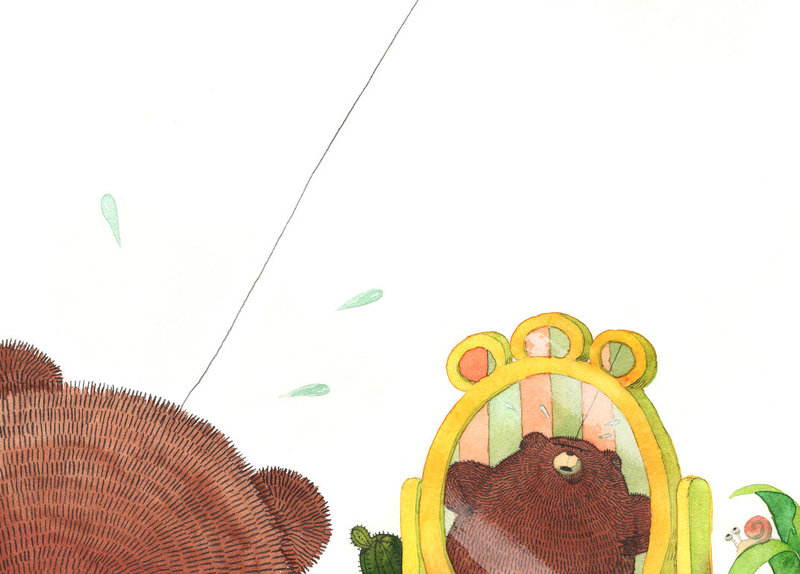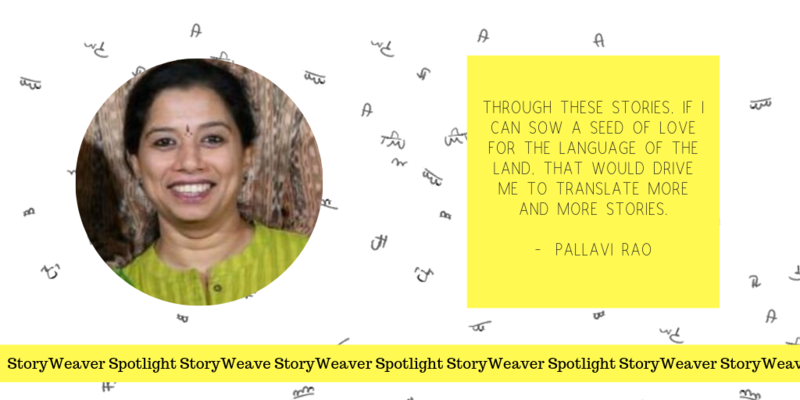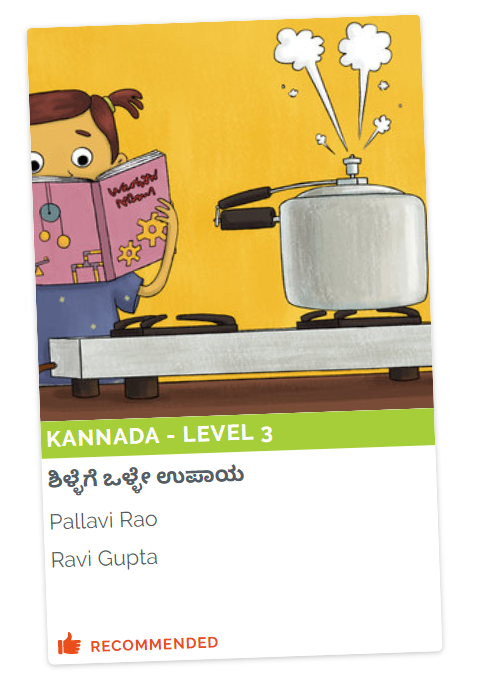ಈ ರಾಜ್ಯೋತ್ಸವದಂದು ನಿಮ್ಮ ಮಕ್ಕಳಿಗಾಗಿ ಒಂದೈದು ಒಳ್ಳೆ ಕತೆಗಳು
Posted by Remya Padmadas on November 01, 2019Written by Bhargavi G.M., Editor - Kannada, Pratham Books
In the journey of re-telling a story in our own language, we often fall in love with a few of our own translated stories and they remain our favorites forever! On this Kannada Rajyotsava, we welcome you to StoryWeaver to read some such gems. What makes them our favorite, and why do we feel they are timeless? Read on to know more…
1. The Koel with the Sore Throat - ಕೋಗಿಲೆಗೆ ಗಂಟಲು ನೋವು (Level 2)
https://storyweaver.org.in/stories/35038-kogilege-gantalu-novu
ಶಾಲೆಯಲ್ಲಿ ಚಿಕ್ಕಮಕ್ಕಳೂ ಕನ್ನಡಕ ಹಾಕಿರುವುದನ್ನು ಬಹುತೇಕ ಸಲ ನಾವು ಗಮನಿಸುತ್ತೇವೆ. ಹದಿನೈದು ಇಪ್ಪತ್ತು ವರ್ಷಗಳ ಹಿಂದೆ ಮಕ್ಕಳಿಗೆ ಹೀಗೊಂದು ದೃಷ್ಟಿ ಸಮಸ್ಯೆ ಬರಬಹುದು, ಅವರಿಗೆ ಕನ್ನಡಕ ಕೊಡಿಸುವ ಮೂಲಕ ಶಿಕ್ಷಣ ಮುಂದುವರಿಸಬಹುದು ಎನ್ನುವುದು ಎಷ್ಟೋ ಪಾಲಕರಿಗೆ ಗೊತ್ತಿರಲಿಲ್ಲ. ಕಾಲ ಬದಲಾಯಿತು ಒಂದನೆಯ ತರಗತಿಯ ಮಗುವೂ ಮೂಗಿನ ಮೇಲೆ ಕನ್ನಡಕ ಏರಿಸಿ, ಗತ್ತಿನಿಂದ ಪಾಠ ಕಲಿಯುವ ನೋಟವೊಂದು ಸಾಧ್ಯವಾಯಿತು.
ತೀರಾ ಏಳೆಂಟು ವರ್ಷಗಳ ಹಿಂದಿನವರೆಗೂ ಕಾರಣಂತಾರಗಳಿಂದ ಕಿವಿ ಕೇಳಿಸದೆ ಶಾಲೆ ಬಿಟ್ಟ ಮಕ್ಕಳ ಸಂಖ್ಯೆ ಸ್ವಲ್ಪ ಹೆಚ್ಚೇ ಎನ್ನುವಷ್ಟು ಇದೆ. ವಯಸ್ಸಾದವರಿಗೆ ಕಣ್ಣು ಕಾಣದಿರುವುದು, ಕಿವಿ ಕೇಳಿಸದಿರುವುದು ವಯೋ ಸಹಜ ಸಮಸ್ಯೆ. ಮಕ್ಕಳಿಗೆ ಹಾಗಲ್ಲ. ಆದರೆ ಮಕ್ಕಳಿಗೆ ‘ಹಿಯರಿಂಗ್ ಏಡ್’ ನಿಂದಾಗುವ ಪ್ರಯೋಜನ ಮತ್ತು ಅದನ್ನು ಬಳಸುವ ರೀತಿ ಹೇಳಿ ಕೊಡುವುದು ಹೇಗೆ? ಅದು ಈ ಕಥೆಯಲ್ಲಿ ಮೂಡಿ ಬಂದಿದೆ. ಈ ಕಥೆಯ ಕನ್ನಡ ಅನುವಾದ ಮಾಡಿದ್ದು ಒಬ್ಬ ಟೀಚರ್ ಮತ್ತು ಅವರ ಮಗನಿಗೆ ಒಂದು ಕಿವಿ ಸರಿಯಾಗಿ ಕೇಳಿಸಲ್ಲ ಎನ್ನುವುದು ಕಥೆ ಹೆಚ್ಚು ಇಷ್ಟವಾಗಲು ಕಾರಣವಾಯಿತು.
2. The Louse's New House - ಹೇನಿನ ಹೊಸಮನೆ (Level 2)
https://storyweaver.org.in/stories/36056-henina-hosamane
ಈ ತಲೆಮಾರಿನ ಮಕ್ಕಳಿಗೆ ಹೇನಿನ ವಿಷಯ ತೀರಾ ಹೊಸದು. ಗೊತ್ತೇ ಇಲ್ಲ ಅಂದರೂ ಅಡ್ಡಿಯಿಲ್ಲ. ಅಲ್ಲೊಬ್ಬರ, ಇಲ್ಲೊಬ್ಬರ ತಲೆಯಲ್ಲಿ ಹೇನು ಕಂಡ ಮಕ್ಕಳು ಅಚ್ಚರಿ ಪಡುತ್ತಾರೆ. ‘ಹೇನುಗಳು ಏಳು ಹಾಸಿಗೆ ದಾಟುತ್ತವೇ’ ಎನ್ನುವ ಕಥೆಯನ್ನು ನಾವು ಮಕ್ಕಳಿದ್ದಾಗ ಅಚ್ಚರಿಯಿಂದ ಕೇಳಿದ್ದೆವು.
ಆದರೆ ಹೀಗೆ ರಾಜನೊಬ್ಬ ತಲೆಯಲ್ಲಿ, ಕೂದಲಿನ ಸುಪ್ಪತ್ತಿಗೆಯಲ್ಲಿ ವಾಸ ಮಾಡಬೇಕು ಎಂದು ಕನಸು ಕಾಣುವ, ಹಾಗೂ ಹೀಗೂ ಹೊಸ ಮನೆ ತಲುಪಿ ಬೆಸ್ತು ಬಿದ್ದ ಹೇನಿನ ಬಗ್ಗೆ ಕೇಳಿರಲಿಲ್ಲ. ವೈಯಕ್ತಿಕವಾಗಿ ನನಗಿಷ್ಟವಾದ ಈ ಕಥೆಯನ್ನು ಮಕ್ಕಳಷ್ಟೇ ಅಲ್ಲ ಅನೇಕ ದೊಡ್ಡವರೊಂದಿಗೆ ಹಂಚಿಕೊಂಡಾಗ ಎಲ್ಲರಿಗೂ ಇಷ್ಟವಾಯಿತು. ಅದರಲ್ಲೂ ಸಾರಥಿಯ ಪಾತ್ರ! ಇಲ್ಲಿಯವರೆಗೆ ಯಾವುದೇ ಮಕ್ಕಳ ಕತೆಯಲ್ಲಿ ಹೆಣ್ಣುಮಗಳೊಬ್ಬಳು ರಾಜನ ರಥದ ಸಾರಥಿಯಾಗಿರುವುದನ್ನು ಓದಿರಲಿಲ್ಲ. ಅರೇ ಹೌದಲ್ಲ ಹೆಣ್ಣುಮಕ್ಕಳೂ ರಥ ಓಡಿಸಬಹುದು! ಎನ್ನುವ ಹೊಸ ವಿಚಾರವೂ ಹೊಳೆದದ್ದುಂಟು.

ಟಿಂಗು, ರಂಗ, ಬಬ್ಲೂ ಕತೆಯ ಒಂದು ಚಿತ್ರ.
3. The Tino, The Rhear and the Biger - ಟಿಂಗು, ರಂಗ, ಬಬ್ಲೂ! (Level 2)
https://storyweaver.org.in/stories/39902-tingu-ranga-babloo
ಸಾಮಾನ್ಯವಾಗಿ ಪ್ರತಿ ಶಾಲೆಯಲ್ಲೂ ವಾರದಲ್ಲಿ ಒಂದು ದಿನ ಮಕ್ಕಳು ಬಣ್ಣ ಬಣ್ಣದ ಬಟ್ಟೆ ಧರಿಸಿ ಬರುವ ಅವಕಾಶ ಇರುತ್ತದೆ. ನಾನು ಅನೇಕ ಶಾಲೆಗಳಲ್ಲಿ ಗಮನಿಸಿದ್ದೇನೆ ಮಕ್ಕಳು ತಾವು ಎಷ್ಟೇ ಚೆನ್ನಾಗಿ ಬಟ್ಟೆ ಧರಿಸಿ ಬಂದಿದ್ದರೂ ಅವರ ಕಣ್ಣುಗಳು ಮಾತ್ರ ತಮ್ಮ ಸಹಪಾಠಿಗಳು ಧರಿಸಿ ಬಂದ ಬಟ್ಟೆಯ ಮೇಲೇಯೇ ನೆಟ್ಟಿರುತ್ತದೆ.
ಮಕ್ಕಳ ಈ ಆಟವನ್ನು ನೋಡುವಾಗಲೆಲ್ಲ ನನ್ನ ತಲೆಯಲ್ಲಿ ಆ ಮಕ್ಕಳ ಮನಸಿನಲ್ಲಿ ನಡೆದಿರಬಹುದಾದ ಅಥವಾ ನಡೆಯಬಹುದಾದ ಸಂಭಾಷಣೆಯನ್ನು ಓದುತ್ತಿರುತ್ತದೆ. ಮಕ್ಕಳ ಆ ಸಂಭಾಷಣೆಯೇ ಇಲ್ಲಿ ಕಥೆಯ ರೂಪ ಪಡೆದಿದೆ ಎಂದೇ ಅನಿಸುತ್ತದೆ ನನಗೆ. ನನ್ನ ಬಟ್ಟೆ ನಿನಗೆ ಕೊಡುತ್ತೇನೆ, ನಿನ್ನ ಬಟ್ಟೆ ನನಗೆ ಕೊಡು ಎಂದು ಮಕ್ಕಳು ಮುದ್ದು ಮುದ್ದಾಗಿ ಮಾತನಾಡುವಂತೆಯೇ ಈ ಪ್ರಾಣಿಗಳೂ ಅವುಗಳ ಚರ್ಮ ಬದಲಾಯಿಸಿಕೊಂಡು ಪೇಚಾಡುವುದನ್ನು ಓದುವುದೇ ಒಂದು ತಮಾಷೆ.
4. How to Be an Otter - ನೀರು ನಾಯಿಗಳೆಂದರೆ? (Level 3)
https://storyweaver.org.in/stories/60211-neeru-naayigalendare
ಪ್ರತಿ ಮನೆಯಲ್ಲಿ, ಪ್ರತಿ ಮಗುವಿಗೂ ಅಪ್ಪ-ಅಮ್ಮ ಕೊಡುವ ಶಿಕ್ಷಣ. ಏನು ತಿನ್ನಬೇಕು, ಹೇಗೆ ತಿನ್ನಬೇಕು, ದೊಡ್ಡವರೊಂದಿಗೆ ಹೇಗಿರಬೇಕು, ಹೇಗೆ ವರ್ತಿಸಬೇಕು ಎನ್ನುವುದು. ಈ ಕಥೆಯಲ್ಲಿ ನೀರುನಾಯಿ ಮರಿಗಳಿಗೂ ಅಷ್ಟೇ. ತಾಯಿ ನೀರುನಾಯಿ ತನ್ನ ಮರಿಗಳಿಗೆ ಶಿಕ್ಷಣ ಕೊಡುವುದು. ಇಡೀ ಪರಿಸರದಲ್ಲಿ ಅವುಗಳ ಅಸ್ತಿತ್ವವೇನು, ಅವು ಹೇಗಿರಬೇಕು, ಇಡೀ ಜೀವ ವ್ಯವಸ್ಥೆಯಲ್ಲಿ ಹೊಂದಾಣಿಕೆ ಎಷ್ಟು ಅವಶ್ಯಕತೆ ಎನ್ನುವುದನ್ನು ಮಕ್ಕಳಿಗೆ ತಿಳಿಸಿ ಹೇಳುತ್ತದೆ.
ವಿಷಯಗಳನ್ನು ಮಕ್ಕಳಿಗೆ ತಿಳಿಸಿ ಕೊಡುವ ಕ್ರಮ ಪ್ರಾಣಿಗಳಿಂದ ಪ್ರಾಣಿಗೆ ಬೇರೆಯಾಗಬಹುದು. ಆದರೆ ಅಂತಿಮ ಉದ್ದೇಶ ಒಂದೇ ತಮ್ಮ ಮಕ್ಕಳನ್ನು ಜೋಪಾನವಾಗಿ ನೋಡಿಕೊಳ್ಳುವುದು. ವಿಷಯ ಮತ್ತು ಚಿತ್ರಗಳಿಂದ ಎಲ್ಲರನ್ನೂ ಸೆಳೆಯುವು ಪುಸ್ತಕ ನನಗೂ ವೈಯಕ್ತಿವಾಗಿ ಇಷ್ಟ.
ನೀರು ನಾಯಿಗಳೆಂದರೆ? ಕತೆಯ ಒಂದು ಚಿತ್ರ
5. A Whistling Good Idea - ಶಿಳ್ಳೆಗೆ ಒಳ್ಳೇ ಉಪಾಯ (Level 3)
https://storyweaver.org.in/stories/37452-shillege-olle-upaaya
ಪ್ರತಿ ಮನೆಯಲ್ಲಿ ಅಮ್ಮ ಮನೆಯಿಂದ ಹೊರ ಹೋಗುವಾಗ ಮಕ್ಕಳಿಗೆ ಹೇಳುವ ಸಾಮಾನ್ಯ ವಿಷಯ, ಕುಕ್ಕರ್ ಮೂರು ಶಿಳ್ಳೆ ಹೊಡೆದ ತಕ್ಷಣ ಗ್ಯಾಸ್ ಆಫ್ ಮಾಡು ಎನ್ನುವುದು. ಸ್ವಲ್ಪ ಸೋಮಾರಿ ಮಕ್ಕಳಾದರೆ ನಾಲ್ಕು ಶಿಳ್ಳೆಗೊ, ಐದು ಶಿಳ್ಳೆಗೊ ಗ್ಯಾಸ್ ಆಫ್ ಮಾಡುತ್ತಾರೆ.
ಆದರೆ ಕತೆಯಲ್ಲಿ ಬರುವ ನಿವಿ ಮಾತ್ರ ಜಾಣೆ. ಕುಕ್ಕರ್ ಮುಂದೆ ನಿಂತು ಅದು ಶಿಳ್ಳೆ ಹೊಡೆಯುವವರೆಗೆ ಕಾಯುವ ಬದಲು, ಶಿಳ್ಳೆಗಳಾದ ನಂತರ ಗ್ಯಾಸ್ ತನ್ನಷ್ಟಕ್ಕೆ ತಾನೇ ಆಫ್ ಆಗುವ ಮಾಡಿಟ್ಟರೆ ಎಂದು ಯೋಚಿಸುತ್ತಾಳೆ. ಅಡುಗೆ ಮನೆಯಲ್ಲಿ ಇರುವ ಸಲಕರಣೆಗಳನ್ನ ಉಪಯೋಗಿಸಿ ಅವಳು ಮಾಡುವ ಉಪಾಯವೇ ಈ ಕಥೆ. ಕಾರಣ ಮತ್ತು ಪರಿಣಾಮ ತತ್ತ್ವದ ಆಧಾರದ ಮೇಲೆ ನಿವಿ ರೂಬ್ ಗೋಲ್ಡ್ ಬರ್ಗ್ ಎಂಬ ಯಂತ್ರವನ್ನು ತಯಾರಿಸುತ್ತಾಳೆ. ಮನೆಯಲ್ಲಿರುವ ಸಾಮಾನುಗಳಿಂದಲೇ ಇದನ್ನು ತಯಾರಿಸಬಹುದು ಎನ್ನುವುದು ವಿಶೇಷ.
Do join the conversation by leaving your thoughts in the comments section below. You can also reach out to us through our social media channels: Facebook, Twitter and Instagram.
Be the first to comment.ಮಿಂಗ್ ಮಿಂಗ್ ನ ಟೊಂಯ್ ಟೊಂಯ್ ಮತ್ತು ನಗುವಿನ ಗುಟ್ಟು
Posted by Remya Padmadas on December 02, 2019Pratham Books' in-house editor, Hema D Khurshapur, writes exclusively about translations and how they end up giving the feel of the original story, if given a fresh approach. In this blog post, she writes about C.P. Ravikumar's translation of Ming-Ming, Fat Little Bear’s translation into Kannada and the psychology behind laughter.
ಮನುಷ್ಯರ ಮಕ್ಕಳಿಗಷ್ಟೇ ತುಂಟತನ ಸೀಮಿತವೇ? ಪ್ರಾಣಿಗಳ ಮಕ್ಕಳೂ ತುಂಟತನ ಮಾಡಬಹುದಲ್ಲವೇ? ಅದ ರಲ್ಲೂ ಮುದ್ದಿಗೆ ಹೆಸರಾದ ಕರಡಿ ಮರಿಗಳು ತುಂಟತನ ಮಾಡಿದರೆ ಹೇಗಿರುತ್ತದೆ. ಅದೇ ಈ ಪದ್ಯದಲ್ಲಿ ಮೂಡಿ ಬಂದಿರುವುದು. ಕೂದಲಿಗೆ ಉದಾಹರಣೆ ಕೊಡುವಾಗ ನಾವೆಲ್ಲ ಒಂದಲ್ಲ ಒಂದು ಸಲ ಬಳಸಿರುವ ವಾಕ್ಯ, ಅಲ್ಲಿ ನೋಡು ಅವನ ಅಥವಾ ಅವಳ ಕೂದಲು ಕರಡಿ ಕೂದಲಂತೆ ಎನ್ನುವುದು.

Illustrations from the book, Ming-Ming, Fat Little Bear, by Vishnu M Nair
ಕನ್ನಡದಲ್ಲಿ ಕರಡಿ ಮತ್ತು ಕರಡಿ ಮರಿ ಕುರಿತಾಗಿ ಬಹುತೇಕ ಮಕ್ಕಳು ಕೇಳಿರಬಹುದಾದ ಒಂದು ಕವನ, ಒಂದು ಕತೆ ಇದೆ. ಕವನ ಅಂದ್ರೆ ಅದು ಬೇಂದ್ರೆಯವರ ‘ಕರಡಿ ಕುಣಿತ’, ಕತೆ ‘ಜಾಂಬವಂತ’ ಕರಡಿಯ ಕತೆ. ‘ಕರಡಿ ಕುಣಿತ’ ಕವನ ಕರಡಿ ಆಡಿಸುವವನಿಂದ ಶುರುವಾಗಿ, ಮಕ್ಕಳು ಕರಡಿಯನ್ನು ಮುಟ್ಟಿ ನೋಡುವ ಪ್ರಕ್ರಿಯೆ ಮುಗಿದು, ಕರಡಿಯ ಕೂದೆಲೆಳೆ ಮಕ್ಕಳಿಗೆ ದೃಷ್ಟಿಯಾಗದಂತೆ ತಡೆಯುತ್ತದೆ ಎನ್ನುವ ನಂಬಿಕಯೊಂದಿಗೆ ಮುಗಿಯುತ್ತದೆ. ‘ಜಾಂಬವಂತ’ ಕರಡಿಯ ಕತೆಯಲ್ಲಿ ಬರುವ ಕರಡಿ ಮಾತ್ರ ಜೇನು, ಹಲಸಿನ ಹಣ್ಣು ತಿನ್ನುವ ಮುದ್ದು, ಮುದ್ದು ಪ್ರಾಣಿಯಾಗಿ ಮಕ್ಕಳನ್ನು ಸೆಳೆಯುತ್ತದೆ.
ಆದರೆ ಈ ಮಿಂಗ್ ಮಿಂಗ್ ಎಂಬ ಕರಡಿ ಮರಿ, ಇನ್ನೂ ಮುದ್ದು ಮುದ್ದು. ಒಂದು ದಿನ ಬೆಳಗಾಗಿ ಎದ್ದು ನೋಡಿದರೆ ಮರಿಯ ತಲೆಯ, ಮೈಮೇಲಿನ ಕೂದಲೆಲ್ಲ ನೆಟ್ಟಗೆ ನಿಂತಿವೆ. ಅದಕ್ಕೆ ಏನು ಮಾಡಬೇಕೋ ತೋಚುತ್ತಿಲ್ಲ. ಯಥಾ ಪ್ರಕಾರ ಅಪ್ಪ-ಅಮ್ಮ, ಅಣ್ಣ-ಅಕ್ಕ, ದೊಡ್ಡಪ್ಪ-ಚಿಕ್ಕಪ್ಪ ಎಲ್ಲರೂ ಒಂದೊಂದು ಸಲಹೆ ಕೊಡುವವರೇ. ಎಲ್ಲರ ಮಾತು ಕೇಳಿ ತಲೆ ಚಿಟ್ಟು ಹಿಡಿದು ಮಲಗುವ ಕರಡಿ ಮರಿಯ ಕೂದಲು ಮತ್ತೊಂದು ಬೆಳಗ್ಗೆ ಎದ್ದು ನೋಡುತ್ತಲೇ ಮೊದಲಿನಂತಾಗಿ ಬಿಟ್ಟಿರುತ್ತದೆ.
ಇಂಗ್ಲಿಷ್ ನಲ್ಲಿ ಎಲ್ಲವೂ ಸರಿ ಎನ್ನಿಸಿಯೇಬಹುದಾದ ಅಥವಾ ಹಾಗೆಂದು ನಾವು ಭಾವಿಸುವ ವಾಕ್ಯ ರಚನೆಗಳನ್ನು ಕನ್ನಡಕ್ಕೆ ತರುವಾಗ ಎದುರಾಗುವ ಸಮಸ್ಯೆಗಳು ಒಂದೆರಡೆಲ್ಲ. ಅದು ಅನುವಾದ ಪ್ರಕ್ರಿಯೆಯಲ್ಲಿ ತೊಡಗಿ ಕೊಂಡವರಿಗೆಲ್ಲ ಗೊತ್ತಿರುವ ವಿಷಯ. ಈ ಕವನವನ್ನು ಕೂಡ ಇಂಗ್ಲಿಷಿನಲ್ಲಿ ಓದುವಾಗ ಚೆಂದ ಎನಿಸುವ ಪ್ರಾಸಗಳನ್ನು ಕನ್ನಡಕ್ಕೆ ತರುವುದು ನಿಜಕ್ಕೂ ಸ್ವಲ್ಪ ಕಷ್ಟದ ಕೆಲಸ. ಕವನ ವನ್ನು ಟ್ರಾನ್ಸ್ ಫಾರ್ಮ್ ಮಾಡದೇ ಅನುವಾದದಲ್ಲಿ ಸ್ವಲ್ಪ ಮಟ್ಟಿನ ಸ್ವಾತಂತ್ರ್ಯ ವಹಿಸಿ ಒಂದೆರೆಡು ವಾಕ್ಯ, ಒಂದೆರೆಡು ಸಾಲುಗಳನ್ನು ಸೇರಿಸುವ ಮೂಲಕ ಕವನವನ್ನ ಕನ್ನಡದ್ದೇ ಆಗಿಸಿದ್ದು ಅನುವಾದದ ಮಟ್ಟಿಗೆ ಒಳ್ಳೆಯ ಪ್ರಯತ್ನ. ಓದುತ್ತಿದ್ದರೆ ನಗುವನ್ನು ತಡೆಯಲು ಆಗದ ಕೆಲಸ. ಇಂತಹ ಒಳ್ಳೆ ಪ್ರಯತ್ನಕ್ಕಾಗಿ ಅನುವಾದಕ ಸಿ.ಪಿ.ರವಿಕುಮಾರ್ ಅವರಿಗೆ ಅಭಿನಂದನೆಗಳು.
ಬರೀ ಮಿಂಗ್ ಮಿಂಗ್ ಎಂಬ ಮುದ್ದು ಕರಡಿ ಮರಿ ಪದ್ಯ ಕನ್ನಡಕ್ಕೆ ಅನುವಾದಗೊಂಡ ಪ್ರಕ್ರಿಯೆ ಚೆಂದವಾದದ್ದು ಅಂತ ಓದಿದರೆ ಸಾಕೇ... ಓದುವಾಗ ಬರುವ ನಗು, ಹುಟ್ಟುವುದು ಹೇಗೆ ಎನ್ನುವುದರ ಬಗ್ಗೆಯೂ ಒಂದು ಕುತೂಹಲವಾದ ವಿಷಯವಿದೆ.

Illustrations from the book, Ming-Ming, Fat Little Bear, by Vishnu M Nair
ನಗು ಹುಟ್ಟುವುದು ಹೇಗೆ?
ಪ್ರಶ್ನೆಗೆ ಉತ್ತರ ತುಂಬಾ ಸರಳ. ಒಬ್ಬ ಹಾಸ್ಯನಟನನ್ನು ನೋಡಿದರೆ ಸಾಕು, ನಮಗೆ ತಿಳಿಯುತ್ತದೆ! ಆದರೆ ನಗೆ ಸಂಕೀರ್ಣ ವಿಷಯ. ನಾವು ಸಹಜವಾಗಿ ಭಾವನೆಗಳನ್ನು ಅಭಿವ್ಯಕ್ತಿಸುತ್ತೇವೆ. ನಗು ಮನುಷ್ಯರ ನಡುವೆ ಮಾತ್ರ ಕಂಡು ಬರುತ್ತದೆ. ಆದರೆ, ಮನಃಶಾಸ್ತ್ರಜ್ಞರು ನಗುವಿನ ಬಗ್ಗೆ ಎರಡು ಮೂಲಭೂತ ಪ್ರಶ್ನೆಗಳನ್ನು ಇನ್ನೂ ಅಧ್ಯಯನ ಮಾಡುತ್ತಿದ್ದಾರೆ. ಒಂದು, ಜನರನ್ನು ನಗುವಂತೆ ಮಾಡುವುದು ಯಾವುದು? ಎರಡು, ನಗುವಿನ ಉದ್ದೇಶವೇನು? ಜನರು ನಗುವಂತೆ ಮಾಡುವ ಅಂಶ ಯಾವುದು ಅಥವಾ ಜನ ಯಾವುದನ್ನು ತಮಾಷೆ ಎಂದು ಪರಿಗಣಿಸುತ್ತಾರೆ ಎಂದು. ಉತ್ತರ ಹುಡುಕುತ್ತಾ, ಆಲೋಚಿಸುತ್ತಾ ಹೋದರೆ ನಾವು ಮನಃಶಾಸ್ತ್ರಜ್ಞ ಅಥವಾ ತತ್ವಜ್ಞಾನಿಗಳಾಗಿ ಬಿಡುತ್ತೇವೋ ಏನೋ?
ಜನರ ಕೆಲವು ಎಡವಟ್ಟು, ವ್ಯಕ್ತಿಯ ದೌರ್ಬಲ್ಯ ಅಥವಾ ಕುಂದು-ಕೊರತೆ, ಕಾಳಜಿಯ ಸಂದರ್ಭಗಳಲ್ಲೂ ಜನರು ನಗುತ್ತಾರೆ. ನಗುವಿನ ಬಗೆಗಿನ ಮತ್ತೊಂದು ವಿವರಣೆ ಎಂದರೆ, ಇದ್ದಕ್ಕಿದ್ದಂತೆ ನೋಡಿದ ಕೆಲವು ದೃಶ್ಯಗಳು ನಗು ಹುಟ್ಟಿಸುತ್ತವೆ. ಅವು ಸಹಜ ಸಂಗತಿಗಳೇ ಇರಬಹುದು ಅಥವಾ ವ್ಯಕ್ತಿಗಳು ಜತೆಗಿದ್ದಾಗ ಕಣ್ಣ ಮುಂದೆ ನಡೆಯುವ ವಿಷಯಗಳಿರಬಹುದು. ಎಲ್ಲ ರೀತಿಯ ನಗುವಿಗೂ ಈ ಸಿದ್ಧಾಂತ ಅನ್ವಯವಾಗುವುದಿಲ್ಲ. ಕಾಮಿಕ್ ನೋಡಿದಾಗ ಉಕ್ಕುವ ನಗುವೇ ಬೇರೆ, ವಿನೋದ ಸಾಹಿತ್ಯ ಅಥವಾ ಘಟನೆ ನೋಡಿದಾಗ ಉಂಟಾಗುವ ನಗುವೇ ಬೇರೆ. ದೈಹಿಕವಾಗಿ ನಗುವಿನ ಅಂಶವನ್ನು ನೋಡಿದರೆ, ನಗು ಒಳ್ಳೆಯದು. ಇದು ನಮ್ಮ ಶ್ವಾಸಕೋಶಕ್ಕೆ ಮತ್ತು ದೇಹಕ್ಕೆ ಬೇಕಾದ ಹೆಚ್ಚುವರಿ ಶಕ್ತಿಯನ್ನು ಒದಗಿಸುತ್ತದೆ. ನಾವು ಸಾಮಾನ್ಯವಾಗಿ ಹೆಚ್ಚು ನಗುವುದು ಒಂದು ಗುಂಪಿನಲ್ಲಿದ್ದಾಗ. ಈ ಸಿದ್ಧಾಂತದ ಪ್ರಕಾರ ಜನರ ನಗುವನ್ನು ನೋಡಿ ಅವರ ವರ್ತನೆಯ ಟಿಪ್ಪಣಿ ಮಾಡಬಹುದಂತೆ!!
Do leave your thoughts in the comments section below. You can also reach out to us through our social media channels: Facebook, Twitter and Instagram.
Be the first to comment.StoryWeaver Spotlight: Pallavi Rao
Posted by Remya Padmadas on October 04, 2019Pallavi Rao has done her MA in English and loves music, literature and painting. She is the daughter of well-known Kannada writer Vaidehi, and has worked on a compilation of talks by eminent theatre personality Sri B.V Karanth (edited by Sri Muralidhar Upadhya). Pallavi has been teaching PU students in several places and currently resides in Delhi. She has translated several storybooks to Kannada including The Night the Moon Went Missing and A Whistling Good Idea on StoryWeaver.

Q: You carve out time for translating children’s books from a busy life. What do stories in translation bring to young readers?
Young readers unknowingly come to know the culture, way of life and language at a young age itself. I think it is very important to imbibe these qualities at a young age.
Q: What is your personal relationship to language and/or translation?
Kannada being my mother tongue, I have read and listened to several great writers and thinkers in Kannada. I breathe my language and this helps me bring stories into Kannada.
Q: What is your take on translation?
Translation is a very responsible task. You have to translate the story keeping its original flavour intact and at the same time giving it the flavor of the language it is translated into. One should have a grip on both the languages i.e., from which you are translating and the one to which it is being translated into.
Q: Translating certain stories must have required a lot of research, especially when it came to STEM-related terms and concepts. For example, stories like A Whistling Good Idea. How did you explore new objects and concepts?
When I read a story to be translated, I dwell on it and begin thinking it in my language. It helps me to understand the story in local circumstances so that I can translate accordingly. While translating concept-oriented stories like ‘A Whistling Good Idea’, I felt it was such a nice way to make a child understand the concept in a playful manner. Difficult concepts are quite hard for children, but when the same concept is told through games, it becomes simple and hence is more understandable and easy for a child.

'A Whistling Good Idea', translated by Pallavi Rao
Q: You have contributed for us immensely. How has the StoryWeaver journey been? What is one big takeaway from this experience?
Overwhelming. By repeatedly wearing a child’s shoe while translating, it has made me more observant and my mind keeps weaving stories for children from whatever I observe around me!
Q: How do you feel when your story reaches the child?
If I can ignite the imagination of a child and add to the child’s vocabulary through my stories, nothing would be more satisfying.
Q: What is your key driver in taking up translation of stories into Kannada?
I have a very strong feeling towards my language. Children in big cities in my state rarely speak Kannada, which is very disturbing. Through these stories, if I can sow seed of love for the language of the land - that would drive me to translate more and more stories.
Q: How else do you think we can join hands to take more stories to more children in more languages?
India has abundant folk stories and poems for children in regional languages. They have to be made reachable to more children in other languages too. For example, in Kannada, we have stories of Panje Magesh Rao, Hoysala, Ullala Mangesh Rao, Ugrana Mangesh Rao, Rajaratnam and so on. Apart from translating stories from English to regional languages, I feel that we should also translate stories from regional languages to English and to other regional languages as well.
Q: When you have been given a story to translate, what is your process, and how long does it generally take?
I read the entire story two or three times, linger on the story and try to visualize the same while working on other chores. I try to keep the language simple, use more of sound words to make it more attractive and increase the vocabulary in children.
Q: What is the hardest thing about translating from English into Kannada? How do you navigate words or phrases that are tricky to translate?
Certain English concepts are not present in Kannada. For example, we don’t have a ‘cape’ in our costume. In such times we have to coin a word in Kannada and ensure that the image is translated successfully to the child.
Q: Do you have any advice for anyone interested in becoming a translator?
Keep the language as simple as possible and make it interesting for children by visualising the story yourself to get the best output.
Q: A book you'd like to recommend to other translators?
From the ones that I have translated it would be ‘A Whistling Good Idea’.
Q: Can you tell us anything about yourself and your job that would surprise us?
Cooking and painting interests me to a large extent. Experimenting techniques in both the fields are the same, I feel.
We would love for you to join the conversation by leaving your thoughts in the comments section, or on social media: Facebook, Twitter, Instagram
Be the first to comment.